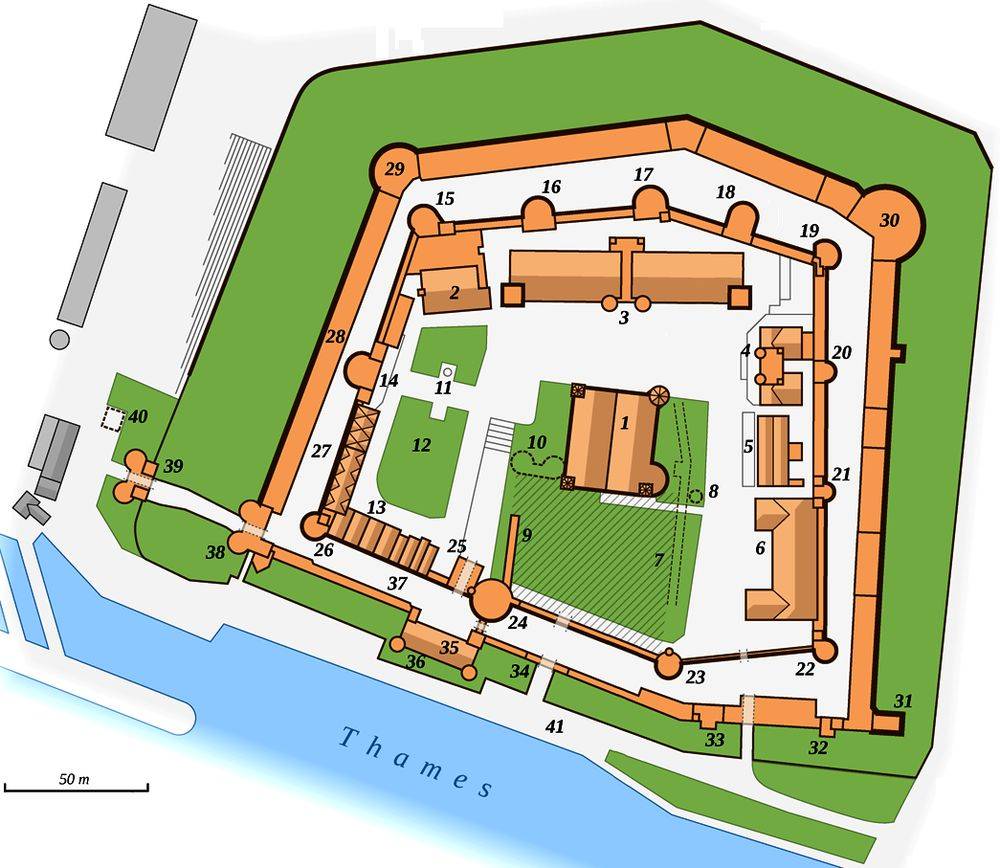The Tower of London is a fortress located in the heart of the capital of the United Kingdom, London. A key castle in the defense of British territory in its entirety, it commanded the passage of ships on the Thames as well as the capital. Those who held this citadel were the masters of the British Isles, it was truly an important fortress, whose history lives up to its recognition in the World.

Byward tower
In practice it is a tower, the famous white tower, tower surrounded by two concentric ramparts forming an irregular hexagon. The interior of the first rampart is equipped with a large number of buildings, forming a real small town on its own.
Map of the Tower of London
Here is the map of the Tower of London

List of buildings
11. Scaffold site
12. Tower green
13. Queen's house
14. Beauchamp tower
15. Devereux tower
16. Flint tower
17. Bowyer tower
18. Brick tower
19. Martin tower
20. Constable tower
22. Salt tower
23. Lanthorn tower
24. Wakefield tower
25. Bloody tower
26. Bell tower
27. Mint street
28. Casemates
29. Legge's Mount
30. Brass Mount
31. Develin tower
32. Well tower
33. Cradle tower
36. Traitors gate
37. Water line
38. Byward tower
39. Middle tower
40. Lions tower
41. Tower wharf
Main buildings
It is very painful to have to indicate the main buildings of the Tower of London so it would be a pity not to go to see the lesser known buildings. But if your visit time is limited, do not miss:
- La White tower
- La Waterloo block
- Le Headquarters of fusillers
- La Beauchamp tower
- Le Scaffold
- As well as the round path
Tours
There are not really tours to the Tower of London, but rather a free discovery of the fortress. The gray buildings on the map on the left are the administrative and tourist buildings, where you buy or collect your tickets if you ordered them. The entrance is by the Byward towers (39), the famous twin towers holding a drawbridge. You will have passed the ruins of the Lions Tower before (40). The classic tour leads tourists along the bank street (37), an unofficial name for this street drawn between the two ramparts and skirting the Thames from inside the fortress. It leads you to the three passages to enter the second enclosure via the Bloody Tower (25) for the most known of these passages. You find yourself between the white tower (1), magnificent from this point of view, and the lawns (12) at the end of which is the memorial to the executed (11). The tour of the white tower is not only indispensable but very interesting, you will spend time there.
At the end of this visit you will naturally see the jewels of the crown, in the Waterloo barracks (3), then the royal headquarters of the fusilliers (4) and its museum. There is a staircase between this building and the barracks leading you to the ramparts and the circular path that leads you through the North Towers: Tour Martin (19), Brick (18), Bowyer Tower (17) , Devereux (15). The Beauchamp Tower (14) can be visited from the lawn, on the ground floor. A walk in the Mint street will allow you to discover the casemates and its numismatic exhibitions.
This is an example of a visit, but the best thing about the Tower of London is to lose itself voluntarily and to ensure, after a while, that we have seen the main buildings because it There are a number of small corners leading to a staircase, a passage or an uncrowded tower that can contain interesting information about the history of London.
See also:





















